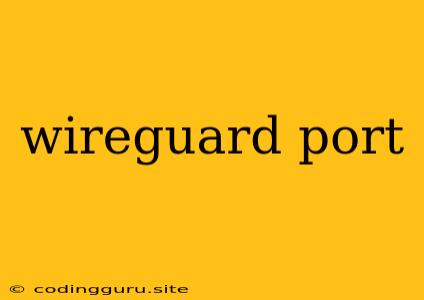Understanding WireGuard Ports: A Comprehensive Guide
WireGuard, known for its simplicity and speed, requires careful port configuration for optimal performance and security. This guide will delve into the crucial aspects of WireGuard ports, addressing common questions and offering solutions for a seamless experience.
Why are Ports Important for WireGuard?
Ports act as gateways for communication between your device and the WireGuard network. They specify which "door" or "channel" data packets should use to enter and exit your system. By default, WireGuard listens on port 51820. This means that any incoming WireGuard traffic will attempt to connect through this port.
What Ports Does WireGuard Use?
While port 51820 is the standard, WireGuard offers flexibility in choosing alternative ports. Here's why this flexibility is important:
- Security: Choosing a non-standard port can make it harder for attackers to identify and exploit potential vulnerabilities.
- Firewall Compatibility: Some firewalls or network configurations may block specific ports. Choosing an alternative port might be necessary to bypass such restrictions.
- Port Conflicts: If other applications are already using port 51820, choosing a different port avoids conflicts and ensures smooth operation.
How to Change the WireGuard Port?
The process for changing the WireGuard port varies slightly depending on your operating system and configuration method. Here's a general overview:
- Open your WireGuard configuration file: The file typically resides in a directory specific to your OS (e.g., /etc/wireguard/ on Linux).
- Locate the "ListenPort" line: This line specifies the port used for incoming connections.
- Change the port number: Replace 51820 with your desired port number. For example, ListenPort = 51821.
- Save the changes and restart WireGuard: Ensure you save the modified configuration file and restart the WireGuard service to apply the new port settings.
What are the Best Practices for Choosing WireGuard Ports?
- Avoid well-known ports: These ports are often targeted by attackers, so it's advisable to choose a less common port.
- Use a high port number: Ports above 1024 are considered "ephemeral," making them less likely to be targeted.
- Consider your network setup: Ensure your chosen port is not blocked by your firewall or other network configurations.
- Use a consistent port across all your devices: This ensures smooth communication between your WireGuard peers.
Troubleshooting WireGuard Port Issues
If you encounter issues with WireGuard after changing ports, here are some troubleshooting steps:
- Verify the port is open: Use tools like
netstat(Linux/macOS) ortcpview(Windows) to confirm if your chosen port is open and listening for connections. - Check firewall settings: Make sure your firewall allows traffic on the chosen port.
- Review your configuration file: Ensure you've saved the changes correctly and restarted WireGuard.
- Restart your network devices: Occasionally, restarting your router or modem can resolve connectivity issues.
Conclusion
Choosing the right WireGuard port is crucial for optimal security, performance, and compatibility. By understanding the role of ports in WireGuard and following best practices, you can set up a robust and reliable connection. Remember to always prioritize security by selecting less common ports and carefully configuring your firewall rules.
